Do you have a busy life and struggle to save money? Do you find yourself asking “Where did all my money go?” at the end of the month? It’s completely understandable that you didn’t save any money at all. We all need a little need help with saving every once in a while. Tracking savings using an app, journal or template is a great way to save money and get ahead.
Read on to learn about tracking savings.
What is the Tracking Savings Method?
In our daily lives, we spend a lot of time taking care of what we need to do. It’s easy to live life on autopilot. On Monday morning, the alarm clock rings. You get up, get dressed, take a shower and rush to work after having scarfed down a half-eaten banana. Even if you work from home, tracking savings is the last thing on your mind. However, the importance of saving money cannot be understated – we all need it to pay for things in life!
That’s when the tracking savings method comes in. If you have a desire to save money while spending a minimal amount of time tracking savings, this article is for you!
Tracking savings allows you to keep a record of:
- How much you’ve saved this month (and year)
- How much you need to save in the short-term
- How much you need to save in the long-term
- How much money you can spend this month – or year – on specific items
There are many ways to track savings. Depending on your objectives, experience with budgeting and personality, choose a way to track savings that works best for you – get creative!
How to Get Started with Savings Tracking
There are several ways of tracking savings, including:
- Google Sheets or Excel spreadsheets
- Pinterest templates – saving and tracking
- Budgeting apps
- Journalling
- Using tools such as the 12 essential budgeting categories
Let’s review each method and how to use each one to track savings.
Excel or Google Spreadsheets
If you’re familiar with using spreadsheets, using one for tracking savings is a common and simple way to get started on your budgeting journey.
Why use spreadsheets to track your savings? Simple – many people already use these in their everyday lives. If you work in an office job, you’ve most likely used these before. Spreadsheets are also a great way to manage your personal life. While there may be a learning curve to use these apps, once you learn the basics – including some keyboard shortcuts and learning how to make use of templates – you’ll be a budgeting whiz!
Determine Your Current Spending, Saving and Investing Habits
Each week, set aside some time – ideally the same time so you build good habits – to go through what you’ve spent your money on in the last 3 months. Take an inventory of how much you spent within the following categories:
- Fixed Expenses – mortgage or rent payment, utilities, car payment, any credit card or loan debt
- Variable expenses – ‘fun’ things like entertainment. This category also includes groceries, as the amount can vary from month to month
- Savings – the amount you’ll save, invest or both after you’ve covered your essential and ‘fun’ expenses.
When it comes to using an Excel or Google Sheets template to participate in a tracking savings challenge, don’t reinvent the wheel. There are thousands of templates available online to – both free and paid. Using a template for your money challenge will save you time and can even save you money. If you take a lot of time to create something from scratch, you might be losing out on time for paid work or time with your family. While you can make a template from scratch, this is often quite time-consuming – and frankly, arduous and boring for the average person.
There are many templates available online to help you get started. Search for one that you like, print it out and give it a try. If you don’t like it, you can always switch to another one!

Track your savings using a journal or other method. Experiment and get creative!
Pinterest Templates
Pinterest is another popular option. It’s fun to get creative and browse different templates. There are many different options, from participating in a penny savings challenge, the printable 52 week money challenge, or a no spend challenge. There are many options to help you get creative with saving money. Find a fun savings tracker that you like and you’ll want to use again and again.
Print templates and stick them in a visible place in your home or office. Printable templates are ideal for those who need visual reminders of their progress. The majority of people will benefit from using Pinterest templates as a visual reminder. Why? The term ‘Out of sight, out of mind’ rings true. When you don’t see something, it’s easy to forget about it. Having a daily reminder can help you work towards your goals, especially if they’re longer-term. It’s easy to get off track and forget why you’re saving in the first place. Keep the big picture in mind by using a template.
There are so many digital budget planner templates on Pinterest to help you get started with tracking savings. Get started with creative savings and have fun with it!
Budgeting Apps
Don’t want to use paper or a spreadsheet? Not to worry – budgeting apps are popular for a reason! Keep everything digital and organized on your phone. There are many options out there to keep you on track with your short-term and long-term savings goals, but let’s focus on a few of the top apps. Each app is different, so feel free to experiment and try different apps and strategies. Use an app that works best for you – no two apps (or people) are the same, so sue whichever strategy works best for you!
Here are three of the top budgeting apps for tracking savings:
- Mint – set a budget for each spending category and link your checking, savings and investing accounts to the apps. Set a budget amount for each category. Mint will track your spending in each category.
- Honeydue – this app is designed for you and a partner. It’s a great option if you’re trying to get on the same page financially. You’ll each be able to set your own financial goals. Additionally, connect all your accounts in one single spot.
- YNAB (You Need a Budget) – this app uses the zero-based budgeting system. Every dollar you make gets a job – it’ll be either saved, spent, or invested. The YNAB app is ideal for those who are just getting started with saving and need a more ‘hands-on’ app to manage their money.
Like This Article? Pin It!
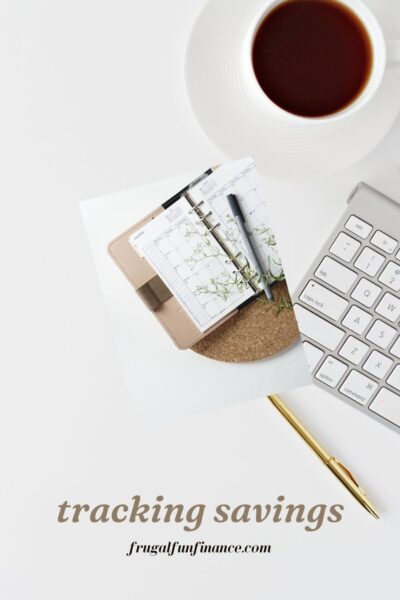
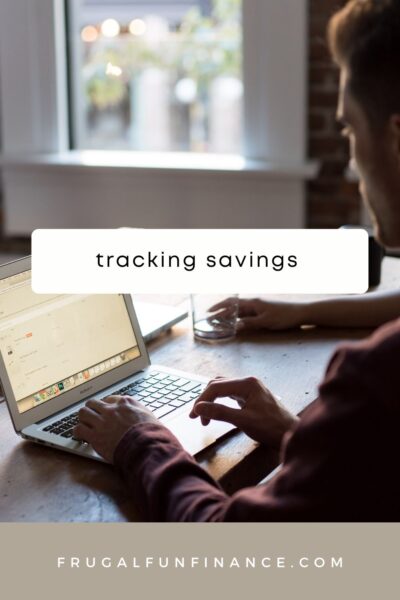
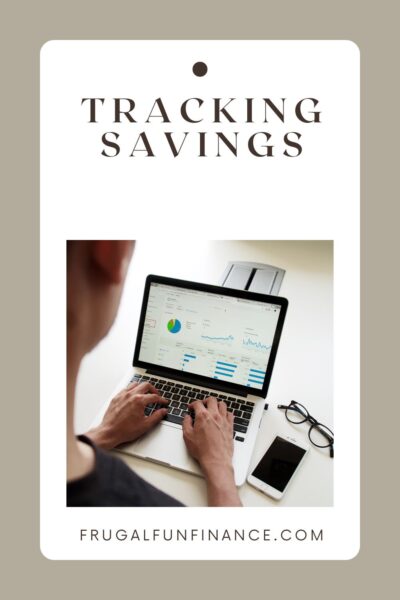
Journalling
Journalling is the simplest and easiest method to track savings. To get started, buy a nice one that you’ll be motivated to write in. Take a look at different journals on Amazon.
Next, write down each item you spent money on and how much it cost. At the end of the month, add the items up to get the total amount that you spent. Take it one step further by assigning each expense a category – wants, needs and saving/investing. Add up each category separately to find how much you spent.
One disadvantage of this method is that you’ll have to add up your expenses manually, as opposed to a budgeting app, which will typically add up your expenses in each category automatically.
However, one major advantage of journalling is remembering what you write down. While I haven’t found any scientific proof that journalling is more effective than using a budgeting app, studies show that you’re scientifically more likely to remember the information you wrote as opposed to typing it out. If you remember the goals you’ve written down and the progress you’ve made, you’ll keep these good habits in your head. When you go to the store, you’ll remember your progress and you’ll think twice before buying that new speaker set you don’t need!
Accountability Coach
I’ve touched on several practical ways to track your savings, but what about keeping yourself accountable? An accountability partner can help you reach your goals faster by holding you to your word.
What is an accountability coach – specifically, for personal finance? Simply put, an accountability coach is a trusted person who meets with you on a regular basis to go over:
- Your financial goals – how much you want to save in the short-term and long-term
- How close you are to your goal so far
- Any frustrations and struggles you’ve encountered
- Next steps to keep on track for success.
Finding an Accountability Partner
An accountability coach doesn’t need to be a professionally-paid expert. Sometimes, all you need is a trusted family member or friend who you can confide in. In addition to being a friend who has your best interest in mind, a friend knows your personality and motivations. They may be able to understand where you’re coming from better than a professional who may only talk about the benefits of saving money from an objective point of view.

Additionally, if you work with a family member or friend, you can also hold them accountable! Just be sure to choose a family member or friend with whom you don’t have an awkward financial history with or someone you owe money to. If you’re chatting with your aunt who loaned you $2,000, there may be some awkward moments if you tell her you haven’t saved any money towards paying her back. This is one major downside of having a family member or friend as a financial accountability coach – there may be some emotions that could interfere. Whatever you decide to do – whether hiring a professional coach or confiding in a family member or friend – choose carefully!
Having an accountability coach or partner doesn’t replace tracking savings using a spreadsheet, app or template. This strategy should be used in conjunction with one of these three methods.
How Do I Track Multiple Savings Goals?
While budgeting apps, templates or spreadsheets are great for tracking everyday savings on a monthly budget, you’ll want to find a way to track multiple savings goals outside your regular budget.
Adjusting Your Budget
One solution is to create a line item in your budget on a temporary basis. For example, if you have an $1000 plane ticket to pay for in 5 months, spend the next 5 months saving up $200 under a category called ‘Airline Ticket.’ Once you’ve saved up, you can remove that category and/or replace it with another category.
In addition to creating different categories, you can be more intentional with saving by how your money is divided. I like to keep separate bank accounts for each major financial goal. For example, I have a savings account for travel, one for emergencies and one for an upcoming splurge I’ll be making on some new clothes.
Transferring Money to Your Bank Account
After you get paid, transfer the money to each account accordingly. Manually transferring money is rewarding because you’ll see your accounts grow. If you’ll forget to transfer money, you can also set up auto deposit – a specified amount will automatically be deposited on a date or time interval of your choosing. Many banks offer this option, so do your research and choose an option that works best for you.
If you still want to do the manual method but are forgetful, set a reminder on your phone. Personally, I like transferring money manually. Why? My income fluctuates each month as I’m currently not salaried. Additionally, as mentioned above, it’s a great feeling to see the money get transferred in my savings account. I feel happy and satisfied when I receive the email that my transfer was completed successfully.
Saving Money in a Jar
Another option is to go old school by saving money in a jar! Reuse a jar, decorate it and label it with your goal. Saving money in jars can be lots of fun because you can get creative. Search on Pinterest for ideas – you can use ribbon, paint or bows to jazz it up. You may even want to print pictures of your goal and affix them to the jar. Why not make a collage of your vacation destination that you’re saving towards?
Once you’ve found a jar and decorated, get saving. Decide how much money you need to save up, and what you’re saving up for. If you have many things to save up for, make a list and then narrow it down based on importance. Choose one item you want to save up for the most. First, determine when you’ll need to purchase the item and how much you’ll need to save per month. If your trip will cost you $2000 and you need to pay for it in 5 months, your goal will be to set aside $400 per month for five months.
Each week – or every time you get paid – withdraw a predetermined amount of money from your bank account and deposit it into a jar. Place the jar in a visible area where you’ll pass by it multiple times a day. A visual reminder will help you remember what you’re working towards.
Choose whichever method words for you. Just stay consistent with your goals, and you’ll make progress!
Benefits of Savings Tracking
There are a number of benefits to tracking savings. When you become more intentional about how much you save and why, you’ll become more satisfied with what you have. Additionally, you may even become disciplined in other areas of your life. If you keep with the good habit of tracking savings, you may find yourself starting other frugal living habits including price comparing supermarkets, investing in a minimalist wardrobe or participating in a no spend month. In my experience, once I started tracking savings and my spending, I experienced the following benefits:
- An increased desire to exercise and stick with my workout routine
- Better time management skills as I need to set aside time each week to track savings
- A greater appreciation for the simple pleasures in life
- A drive to participate in another type of money challenge such as the 52 week money challenge that allowed me to successfully save up for a 2-month trip to the UK, Cyprus, Germany, Portugal and Spain
- A general sense of accomplishment after having hitting many of my saving and investing goals
Drawbacks of Savings Tracking
While there are many benefits that vastly outweigh the drawbacks of saving, there is one major drawback. If you are constantly tracking savings, it’s easy to fall into the habit of constantly worrying about finances. Before you know it, you might be constantly focusing on saving as much money as possible, falling into ‘being cheap’ territory. That’s why it’s important to also set aside money to treat yourself every once in a while. Keep saving every week, but once a month or so, reward yourself with a treat. Don’t deprive yourself of fun!
Conclusion – Tracking Savings
Tracking savings doesn’t have to be hard. Pick a strategy that works for you and get saving! There are so many different ways to save money. Tracking savings is a great way to keep on track with your goals and keep on top of your net worth (how much you own versus owe). Find a money goal tracker that works for you and stick to it!
Like This Article? Pin It!
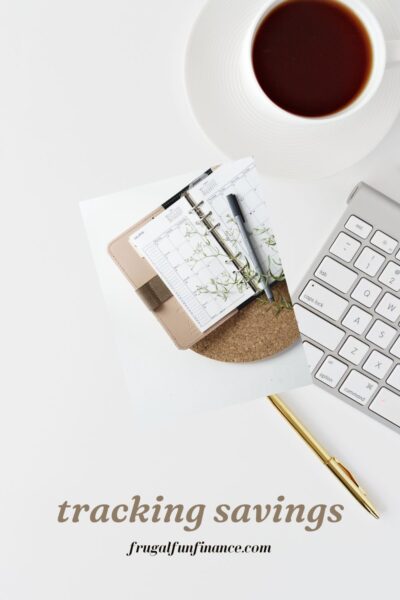
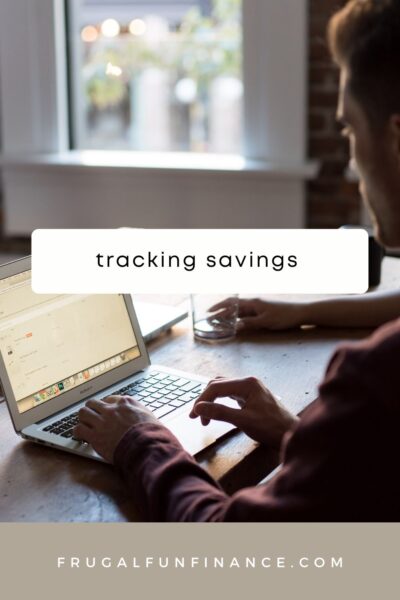
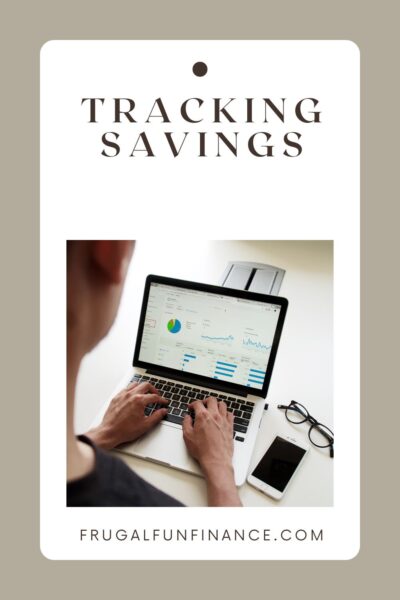
Janita is a frugal living expert and owner of Frugal Fun Finance. With over five years of personal experience finding and trying out the best ways to make and save more money, she's eager to share her knowledge. Janita's strategies have helped her save thousands of dollars for funding investments and traveling to over 20 countries.
Janita completed training in personal finance at The University of Western Ontario and McGill University, two prestigious Canadian universities. Her expertise has been shared on GoBankingRates, Yahoo Finance, and NASDAQ.com.



